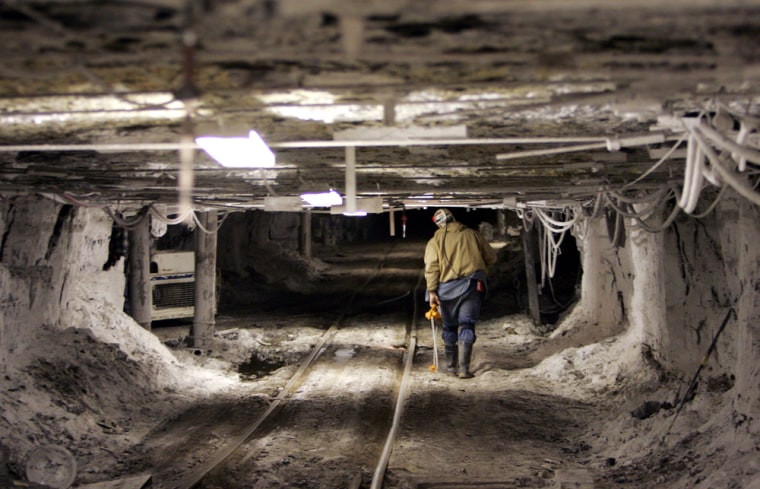With a boom in demand, mining companies can't seem to get the commodities out the ground fast enough.
There are major shortages of the equipment used to move and break up the tons of rock that yield just ounces of metal and that's posing big challenges to an industry that can't seem to feed demand fast enough.
At the Goldstrike mine near Winnemucca, Nev., there is gold, lots of it, in the ground. It takes about 50 tons of rocks to produce one ounce of gold. So all the heavy machinery — from the giant shovels that scoop up the blasted rock, to the trucks that bring that rock to be processed — all of it is crucial. And, in very tight supply.
There are shortages of equipment like massive earth haulers — equipped with 12-foot tires — that can transport 260 tons per load, the equivalent of 520 pickup trucks.
Then there are large electric shovels. Delivery time for these are well over a year.
"We ordered one of those 12 months ago and we'll be receiving one in June. We'll get that in the dirt in October. And we'll have another one arriving next March. So lead times for the electric shovel are 12-18 months," said Roy McKinstry, site manager at the mine.
Why the tight supplies? Past booms usually turned into busts, so manufacturers of equipment used to mine everything from coal to copper, held back from boosting production. Until now.
At Caterpillar's Decatur, Ill., plant haul trucks will be rolling off the assembly line four times faster than just three years ago by the end of this year. Makers of monster tires like the 15,000-pounders with a 13-foot diameter are shifting into high gear too. Michelin is expanding a plant in South Carolina, and Bridgestone is upping production by 20 percent in Japan.
In the meantime, the mines can't wait.
At Phelps Dodge's Morenci Copper Mine in Arizona, site manager Peter Quinn is making the most of the equipment he has to keep production on target.
"Pit floor conditioning, haul road improvement, ensuring that haul road surfaces are as smooth and clean as we can get them, (all) extend tire life and truck performance," Morenci says.
Technology is also key to this age-old industry's efficiency kick. Back at Goldstrike computers notify haul trucks if they've hauled too much, too fast. This can shorten tire life and damage the equipment.
Mckinstry says the last bust in the mid-'80s taught mines how to make what they have last, like extending tire life by 35 percent.
"That has paid us dividends now, with the upturn in the mining business," McKinstry, the gold site manager, says.
Shortage of miners
Apart from equipment shortage, the mining industry is facing another huge challenge. Just as demand is hitting historical highs, there is an acute shortage of miners — from truck operators to trained geologists —and it’s forcing the mining industry to get creative, in order to keep production humming.
It's not a job many would be willing to take — descending 1,750 feet underground everyday —to mine for gold deposits in the dark with 110-pound drills in temperatures that can reach 100 degrees.
But for C.Y. Vlahos and 319 other miners, this is what they do, 12 hours a day.
"I'd never have imagined I'd be an underground miner," Vlahos says.
But that was before he heard about Bgold's Mining Academy, which in two years, has turned out about 60 graduates.
The goal of the mining academy is to train and recruit workers for the Turquoise Ridge mine in Nevada and to address labor shortages faced, not only by the Barrick Gold Corp., but mining companies across the industry. Barrick is the second-largest North American gold producer and the largest in the world by market capitalization.
Labor is the biggest issue facing this industry, according to John Mansanti, site manager at Turquoise Ridge.
"The industry was at a point where you'd be stealing people from one another. You'd be pirating somebody from another property and they'd be doing the same," said Mansanti.
Fewer schools and fewer graduates caused the crunch. The number of programs offering degrees in mine engineering has dwindled by almost half in the past 15 years. Compounding that: an aging workforce.
The coal industry alone will need 50,000 miners — that's nearly 80 percent of the current workforce — in the next five years to replace retirees and expand production. That's making it a job-seeker's market, with wages in the mines growing twice as fast as the overall labor market.
At Barrick, new underground miners — many with only a high school diploma — can make $22 an hour, which is four times the minimum wage. They also get full benefits and three weeks vacation to start.
That's a very different labor market from when Tracy Miller graduated with her mine engineering degree in 1985.
"The graduates are waiting for offers, and they are actually negotiating," Miller says.
All this means that labor costs for the industry are up, on top of rising energy and equipment prices. To top this is the risk of investing in training workers and then losing them if a rival makes a better offer.
But Vlahos says he's here to stay.
When asked if he thinks he'll be on the job in 10 years, he gives a quick "I think so."
Twenty years?
"Hope so."
